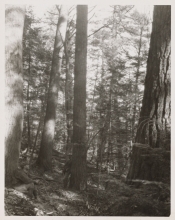You are here
Old-Growth Study Reconstructs Southern NH Forests

A new study in The Journal of the Torrey Botanical Society employs field data collected by Harvard graduate students nearly 100 years ago, providing a unique opportunity to reconstruct how forests in the region looked before Europeans arrived.
The work characterizes the composition, size distribution, recruitment history, and biomass conditions of old-growth forests in southern New England, centered on the Pisgah forest region of New Hampshire.
The research team, led by Jamie Waterman and Anthony D'Amato from the University of Vermont, with co-authors David Foster, David Orwig, and Neil Pederson from the Harvard Forest, found that forest composition ranged from areas dominated by large white pine and eastern hemlock to areas dominated by northern hardwoods. The largest trees across the forests studied tended to be pine and hemlock, with shade-tolerant American beech and hemlock making up the majority of the understory. Large pines had a disproportionately high influence on biomass conditions across forests in which they occurred.
The Harvard Forest Archive was central to the work, allowing Waterman to digitize the century-old data necessary for this study from 1929 master's theses by Branch, Daly and Lotti.
The research team notes that the variability of forests in terms of tree age, size, and composition likely reflects the historic importance of disturbance processes like hurricanes, as well as drought and frost events that are known to have impacted the region in the 17th and 18th centuries.
The work provides important insights for forest management efforts that seek to emulate the natural conditions of old-growth forests.
- Read the full study: Historic forest composition and structure across an old-growth landscape in New Hampshire, USA
(Photo of old-growth forest at Pisgah courtesy of the Harvard Forest Archive)

